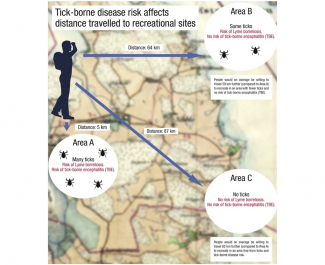FILTER
Displaying 101 - 110 of 248 publications
Tick-borne diseases are emerging and re-emerging threats causing public health concerns in Europe and North America. Prevention and control require understanding of human exposure and behaviour. The…
| Peer Reviewed | Global HubSeveral studies have shown the economic value of various ecosystem services provided by the forest. However, the economic value of how site-specific ecological conditions interact with other functions…
| Peer Reviewed | Global HubProtected areas (PAs) can mitigate climate change by reducing carbon emissions that result from forest loss. Carbon emissions from forest degradation are a large component of forest loss and are often…
| Peer Reviewed | Global HubWho is afraid of ticks and tick-borne diseases? Results from a cross-sectional survey in Scandinavia
Abstract Background In Scandinavia, the distribution of ticks is expanding and tick-borne diseases constitute growing health risks. While the probability of getting a tick-borne disease after a tick…
| Peer Reviewed | Global HubUnderstanding how changes in baseline risk influence preferences for risk reduction is important when valuing the welfare effects of environmental change, including the spread of disease. We conduct a…
| Peer Reviewed | Global HubAbstract Background Tick-borne infections are of emerging and increasing concern in the Scandinavian countries Denmark, Norway and Sweden. Only few studies have investigated protective practices…
| Peer Reviewed | Global HubThe high rates of economic activity and environmental degradation in Asia demand the implementation of creative and cost-effective environmental policy instruments that provide polluters with more…
| Peer Reviewed | China, Sweden, Global HubWe take stock of the lessons learned from using market-based instruments in chemicals management and discuss the potential for increased use of risk-based taxation in the management of pesticides and…
| Peer Reviewed | Global Hub